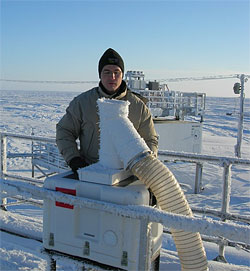Radiometers Operate in Low Water Vapor Conditions in Barrow, Alaska
Published: 31 March 2007

To provide more accurate ground-based measurements of water vapor in extremely arid environments, three types of 183.3-GHz radiometers operated simultaneously in February and March at the ARM North Slope of Alaska site in Barrow. The 183.3-GHz radiometers are part of a new generation of ground-based instruments designed to measure sky radiances in a frequency region of the microwave spectrum that is highly sensitive to the presence of very small amounts of water vapor. Therefore, they are especially useful during the dry arctic winter, when precipitable water vapor amounts are often less than 4 mm. Measurements gathered by the three radiometers will contribute valuable information to the data set collected during the 3-week Radiative Heating in Underexplored Bands Campaign (RHUBC), which began on February 22 and concluded on March 14.
The G-Band Vapor Radiometer (GVR) has been operating in Barrow since April 2005. Developed by Prosensing, Inc. under a Department of Energy (DOE) Small Business Innovation Research (SBIR) grant, the GVR measures sky radiances from four double sideband channels centered at ±1, ±3, ±7, and ±14 GHz around the 183.31-GHz water-vapor line. Data collected by the GVR data are routinely available for download from the Data Archive.
Joining the GVR, a Ground-based Scanning Radiometer (GSR) began operating at Barrow on February 16. Developed by the Center for Environmental Technology at the University of Colorado, the GSR is a 29 channel scanning radiometer that measures radiance in the frequency band from 50 to 400 GHz, providing information about water vapor, temperature, and clouds. In addition to contributing to the RHUBC data set, the GSR will operate until in the middle of July to demonstrate its capability for long term unattended operation, and to study the spectral response of the channels to a wide range of conditions.
The third and newest radiometer, called a MP183A radiometer, began continuous operations from ARM’s Barrow site on February 18. Developed by Radiometrics Corporation under another DOE SBIR grant, the MP183A provides radiometric observations at 15 frequencies ranging from 170 to 183.3 GHz. Data obtained by the MP183A during the RHUBC deployment will be available in the field campaign section of the Data Archive. Continuous data collected from baseline instrumentation at the ARM site in Barrow will be used to supplement the analysis.
The ARM Climate Research Facility is a DOE Office of Science user facility. The ARM Facility is operated by nine DOE national laboratories, including .
Keep up with the Atmospheric Observer
Updates on ARM news, events, and opportunities delivered to your inbox
ARM User Profile
ARM welcomes users from all institutions and nations. A free ARM user account is needed to access ARM data.


















